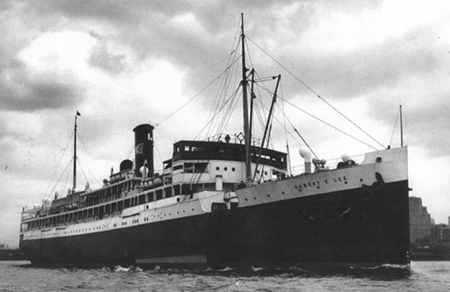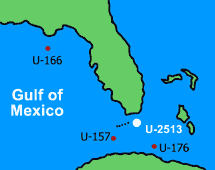The Sinking and discovery of U-166
by Tonya Allen
Introduction: The Most Elusive U-boat Wreck of All
The announcement on 8 June, 2001 that the wreck of U-166 had been located and positively identified finally put an end to decades of fruitless searching for perhaps the most elusive U-boat wreck of all. U-166 had been discovered in May during surveying for an underwater oil pipeline some 45 miles from the mouth of the Mississippi River, in 5,000 feet of water.
Almost exactly 59 years earlier, on 17 June, 1942, U-166 slipped out of Lorient on her first and last combat patrol. Launched on 1 November, 1941 and commissioned some five months later by Oblt. Hans-Günther Kuhlmann, this Type IXC sank four ships (7,593 tons total) before being sent to the bottom herself on 30 July, 1942 by depth charges from a US naval patrol vessel. Her entire crew of 52 accompanied her to the ocean floor. Her short operational life was followed by a much longer shadow existence made up of speculation and rumor, as false reports of her finding proliferated with each passing year. An incorrectly recorded fate, which was accepted by most historians until the wreck's recent discovery, was an additional complication.
First and Last Patrol
Hans-Günther Kuhlmann, one time torpedo officer on the heavy cruiser Blücher, had begun his U-boat career in February, 1940 with an exciting mission aboard U-37 (Hartmann). The boat carried two Abwehr agents with instructions to land them on the southwest coast of Ireland. As Third Watch Officer on this boat, then Leutnant zur See Kuhlmann had volunteered to help one of the agents, who was having difficulty in maneuvering the cockle-shell craft which was to transport him to shore. Kuhlmann took over the handling of the little craft, grounded it close offshore, and then carried both the hapless agent and his luggage to dry land. Only on his triumphant return to the U-boat did Kuhlmann learn from his commander that orders explicitly forbade any of the crew to leave the boat during this mission.
Oberleutnant zur See Kuhlmann's first command ended ignominiously during a training exercise in the Baltic on 11 November, 1941, one day before his 28th birthday. U-580 sank after a collision with the target ship Angelburg; twelve of the crew were killed. The survivors were reassigned to the new U-166. After a short (2 months) work-up period in the Baltic and a cruise from Kristiansand to Lorient, U-166 was ready to begin her first and last mission. It was to combine the tedium of mine-laying with the excitement of patrolling in the still-rich waters off the US coast. May had seen the first sinking in the Gulf of Mexico; U-boats continued to sink shipping in the Gulf until 4 September, 1942.
Leaving Lorient on 17 June, U-166 made a first, unsuccessful attack on 10 July: six torpedoes expended on a small convoy of two freighters and two escorts, all of which missed or malfunctioned.
The next day Kuhlmann used his deck gun to sink Carmen, an 84-ton Dominican sailing ship. Two days later he torpedoed a larger prize, the 2,309-ton American merchant ship Oneida sailing in a heavily escorted convoy of eleven ships. On 16 July he again turned to gunfire to sink the 16-ton Gertrude, an American trawler.
On the night of 24-25 July Kuhlmann laid nine mines at the mouth of the Mississippi River. None of them ever detonated.

Passenger freighter Robert E. Lee
Courtesy of the Mariners Museum, Newport News, VA
On 30 July U-166 claimed her last victim and met her own fate. The 375-foot Robert E. Lee, a privately owned vessel commissioned by the US Navy, was en route from Trinidad to New Orleans with several hundred aboard. Ten of the crew and fifteen passengers were killed when a torpedo found its mark. The remainder were rescued from lifeboats and rafts by naval patrol PC-566, SC 519, and a tug.
PC-566 had turned immediately after the torpedo hit and backtracked from her position approximately one half mile ahead of Robert E. Lee. The patrol boat dropped a total of ten depth charges, one or more of which inflicted fatal damage on the U-boat.
Rumors and Misinformation
Rumors that the wreck of U-166 had been found surfaced regularly over the years. The fact that the boat's official recorded fate was actually incorrect further clouded the issue. Most historians believed that U-166 had survived PC-566's depth charge attack only to be sunk on 1 August, 1942 in a position some miles farther west (28.37N, 90.45W). This attack, in which a US J4F-1 Grumman aircraft (USCG V-212/Y) dropped a single depth charge and claimed a kill, is now thought to have been directed at U-171, which actually escaped unscathed and instead met her end in a minefield in the Bay of Biscay a few months later.
The wreck of U-166 was reported in various locations ranging over 700 miles of the Gulf of Mexico, and was even referred to as a "ghost boat" with a habit of disappearing from one place only to appear in another. A story with no basis in fact but circulating with monotonous regularity held that U-166 carried mercury valued at USD 1 million.
Many claimed not only to have seen this boat from the air (off Clearwater, Florida as well as in the Florida Keys), but also to have dived on it (south of Houma, Louisiana; at the mouth of Tampa Bay; and again northwest of Clearwater, Florida) and removed parts from it. It was also reported to be located "in the panhandle area" of Florida.
While the probable wreck of Robert E. Lee had been discovered in the mid-1980s, the second wreck known to be located nearby had always been thought to be another ship, rather than a submarine. At one time it was thought to be the wreck of Alcoa Puritan, sunk by Harro Schacht in U-507 on 6 May, 1942. In March 2001 it was determined from sonar side-scan that this wreck was the wrong shape for a surface ship, and it began to be suspected that this might indeed be U-166.
Found at Last
In a press conference held on 8 June, 2001 BP Amoco PLC and Shell Oil Co. announced that the wreck of U-166 had been located. During the previous month, C & C Technologies had come upon the wreck while surveying for a new pipeline for the oil companies. Using a 17-foot remote-controlled submarine to scan the sea floor, the surveyors received sonar images that showed the distinctive silhouette of a submarine. Final, conclusive identification was carried out using another remote-controlled vessel to videotape the wreck, which lies beyond the reach of human divers.

The final location of the U-166
This conscientious effort by the two oil companies is especially laudable as it goes well beyond what is required by regulations. The future pipeline's path was rerouted one mile to the west in order to leave the wrecks undisturbed.
U-166 at Rest
U-166 lies partially embedded in silt in a 6-foot deep impact crater, broken into two relatively intact sections. Video footage shows the conning tower, deck gun, and railing of the wintergarten through a storm of plankton. Damage caused by a probable direct depth charge hit is also evident. Although no sign of human remains was observed outside the boat, it is thought likely that due to its partially silted-in condition, skeletal remains are preserved inside. The exact coordinates of the wreck site have not been revealed; as a marine archeological site its location cannot be disclosed.
Less than a mile away lies the wreck of U-166's last victim, also positively identified earlier this year. Both vessels are war graves and as such protected by international treaty. Salvage of the boat from such a depth is unlikely.
Sources
uboat.net, including Forums
Showell, Jak P. Mallmann, U-Boats at War: Landings on Hostile Shores
Blair, Clay, Hitler's U-boat War: The Hunters, 1939-1942
Correspondence received by Guðmundur Helgason
Houston Chronicle, June 9, 2001, "Mystery of the Deep Solved"
This article was published on 1 Aug 2001.
Buy this title at amazon.co.uk |
Books dealing with this subject include
|


